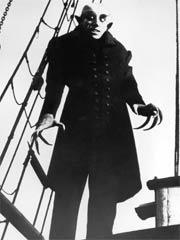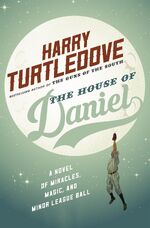
Count Orlock, one of the earliest, and most memorable, vampires depicted on film. From the 1922 German picture Nosferatu.
Vampires are mythological or folkloric beings that subsist on human and/or animal lifeforce. In most cases, they are reanimated corpses who feed by draining and consuming the blood of living beings. In folklore, the term usually refers to the undead blood-drinking humans of Eastern European legends, but it is often applied to similar legendary creatures from other regions and cultures.
Vampire in "Batboy"[]
Vampire Zoltan Nagy acted as a batboy for the St. Louis Browns. In early September, second baseman Laszlo Kovacs became convinced that Zoltan was a vampire, a fact which he proved in Detroit when he caught sight of Zoltan's empty clothing in a mirror.
When Zoltan tried to get into the room Lazslo shared with Rip, the second basemen hammered a spike into his heart and Rip threw a clove of garlic down his throat. After his death, nobody, including Gyula Nagy, supposedly the boy's father, remembered Zoltan, except for Lazslo and Rip.
Vampire in The Case of the Toxic Spell Dump[]
Vampires could vampirize other animals. This included vampsters (vampiric hamsters).
Vampire in Clever Rolf Stories[]
A talking cat sought Clever Rolf's help in determine whether or not it was a vampire. After racking his brain for a solution, Clever Rolf showed the cat its reflection in a mirror, proving it was not a vampire. [1]
Vampire in "A Different Vein"[]
A vampire, tired of Hal Williams' stale jokes, had his vengeance on the comedian.
Vampire in Every Inch a King[]
Vampires were common in the Nekemte Peninsula. Otto of Schlepsig and Max of Witte encountered a Lokrian vampire as they were sailing on the Gamemeno from Lokris to Shqiperi.
Vampires were nearly unknown in Schlepsig.
Vampire in "Gentlemen of the Shade"[]
A group of five vampires called the Sanguine Club resided in London, England in 1888. They soon became aware of a sixth vampire, Jack, who came to be known to the world as Jack the Ripper. The others, terrified that the undisciplined Jack would reveal the existence of vampires to the world, invited him to join, only to be rebuffed. Thus, they decided to stop Jack's murder spree. After pursuing him through the fall of 1888, the Sanguine Club captured Jack and walled him up in the foundation of the unfinished Tower Bridge.
Vampire in "The Horse of Bronze"[]
Vampires inhabited territory in the unexplored interior of Eastern Europe, north of the centaurs' homeland and south of a settlement of mans.
When the Centaur Pholus led an expedition into the interior of Eastern Europe in search of tin, he first made contact with vampires. Vampires organized raids against the centaurs by night and sucked the blood of several of the members of his expedition, but the centaurs managed to capture one vampire on one such raid, and Pholus ordered that the vampire be bound tightly in an open clearing. The vampire died a horrible death when the sun rose, and after that incident his countrymen decided to give the centaurs a wide berth.
Pholus passed through the vampires' territory and made contact with the Lapiths north of it. Upon returning home, Pholus suggested that the Centaurs not make war against the vampires because they were the only thing standing between the centaurs and the Lapiths. However, he had no great hope that the vampires would be able to frustrate or discourage Lapith ambitions for long, and indeed the Lapiths did manage to force their way through vampire territory and into the centaurs' homeland.
Vampire in The House of Daniel[]
Vampires originally existed in Europe before some immigrated to the United States at the turn of the 20th century and spread their curse. They were generally a nuisance, although there were some parts of the country where they had achieved enough numbers to be more than a nuisance.[2] When the Big Bubble popped, vampires were as badly hit by the economic downturn as the rest of the country.[3] Still, they were able to grow their numbers by occasionally convincing the living that vampirism was a path to equality in a "brotherhood of blood".[4]
After the Russians killed their Czar, many outsiders wondered if vampires were running the show, as the rhetoric used in Russia was similar to the standard vampire line. They also used a red flag, which many saw as more proof of vampire rule.[5]
Rumor had it that the vampires, through their egalitarian rhetoric, had helped spark the Great Zombie Riots of 1934.[6] While it wasn't proven at the time, the authorities in Denver destroyed zombies and vampires with equal fervor.[7]
Vampire in "None So Blind"[]
While an expedition from the Empire of Mussalmi was still in the jungles of the tropical continent, a native porter cautioned the group about the tsaldaris in the area. After much discussion, using the mage Sunila's translation cantrip with the native, the Mussalmians concluded he was referring to a vampire.
Some of the Mussalmians thought he was either trying to scare them off or at best repeating native superstitions. Others took the warning more seriously and tried to recall whatever lore they knew about vampires. They eventually recalled that vampires were stopped by roses, garlic, and sunlight. When put to the native, he agreed about sunlight and he knew nothing of roses or garlic. The absence of the northern flower was not surprising. When one of the expedition cooks let him sniff garlic, his horrible look suggested he preferred the tsaldaris.
That night some of the expedition rubbed themselves with powdered garlic while the rest did not. The next morning, those who used the garlic and the natives were unaffected. However, Relander, a savant who had not used garlic, lay in his bedroll with an eerie calm look on his face and two puncture marks on his neck; the most contented looking corpse anyone had seen. However, when the rising sun was fully on him, his features screwed up in pain and he began to wither. His body mortified in unnatural haste. To ensure he remained dead, the expedition pounded a stake through his heart and a cook placed a clove of garlic under his tongue.
The following evening, all the Mussalmians rubbed themselves with garlic before entering their bedrolls. However, it did little good. The mage Kyosti awoke in the moonlight and was mesmerized by a tsaldaris staring at him. The garlic was unpleasant to the creature but did not deter it. Kyosti was unable to offer any resistance but he was saved by Sunila and the native who threw a sack over its head. With the enchantment broken, Kyosti assisted them in restraining and binding the tsaldaris. In the morning, when the sunlight touched the creature, it did not merely mortify as did Relander but burst into flames. Shortly thereafter all that remained was a small heap of ashes mainly from the sack and the ropes that held it.
Vampire in "Thicker Than Water"[]
On All Saints' Day, an ancient vampire came upon a village after a long period of hunger. It immediately established the village as its hunting ground. However, after the vampire fed upon a bleeder named Raoul. Raoul's blood turned the vampire into a bleeder. Raoul's brother, Guillaume, overpowered the vampire by causing it to bleed with a chisel. With the vampire weak, Guillaume tied it down and let it burn in the sunrise.[8]
Vampire in "The Thing in the Woods"[]
An entire suburban community was populated by vampires who raised vampire children, who in turn went to a vampire school. Young vampire Tim was worried that a werewolf lived in the woods behind his friend Geoffrey's house. Geoffrey used Tim's fears to have fun at Tim's expense.
Vampire in Three Men and...Stories[]
Dutch scholar Abraham van Helsing roamed the British Isles in search of vampires in the late 19th century. With the help of J., George, and Harris, to say nothing of J.'s dog Montmorency, van Helsing was able to confront and dispatch a vampire and his novice.[9]
Vampire in "Traditions"[]
By tradition, a vampire always killed the count of Sirmion, usually when the count was a ripe old age.[10] However, when the twelfth count, Constans, was killed in the garderobe by a vampire, Constans' son, Manes, attempted to avenge his death and end the tradition. Unfortunately, he failed and was slain by the vampire that killed his father. Manes' six year old son knew early on what would be his ultimate fate.[11]
Vampire in "Under St. Peter's"[]
A vampire named Dacicus transformed Jesus into a vampire shortly after the latter was crucified. Jesus was kept by the Catholic Church in a secret chamber of St. Peter's Basilica. Tradition required that Jesus feed on some of the blood of each newly ascendant pope. Only Pope Honorius I ever became a vampire himself.
See also[]
- Vurkolak, another Eastern European monster sometimes treated interchangeably with vampires.
References[]
- ↑ https://www.patreon.com/posts/new-decameron-36258679.
- ↑ The House of Daniel, loc. 2106-2112.
- ↑ Ibid., loc. 525., ebook.
- ↑ Ibid., loc. 1624-1657, 1743.
- ↑ Ibid., loc. 1652.
- ↑ Ibid., loc. 3920-3972.
- ↑ Ibid., loc. 4248-4285.
- ↑ Fantasy Book, March, 1986 issue, pgs. 12-15.
- ↑ Some Time Later: Fantastic Voyages Through Alternate Worlds, pgs. 13-24, TPB.
- ↑ Amazing Stories, vol. 57, #4, 1983, pg. 91.
- ↑ Ibid., pg. 92-93.
| |||||||||||||||||||||||||||||||||||||||||||||||||||||||||||||||||||||||||||||||||||||||||||||||||||||||||||||||||||||||||||||||||||||||||||
